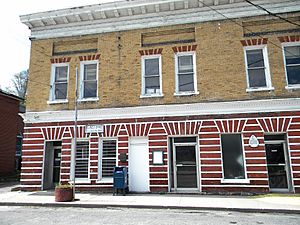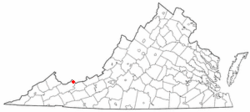Pocahontas, Virginia facts for kids
Quick facts for kids
Pocahontas, Virginia
|
|
|---|---|

Pocahontas, Virginia Post Office
|
|

Location of Pocahontas, Virginia
|
|
| Country | United States |
| State | Virginia |
| County | Tazewell |
| Area | |
| • Total | 0.58 sq mi (1.50 km2) |
| • Land | 0.57 sq mi (1.48 km2) |
| • Water | 0.01 sq mi (0.03 km2) |
| Elevation | 2,330 ft (710 m) |
| Population
(2020)
|
|
| • Total | 268 |
| • Estimate
(2019)
|
353 |
| • Density | 619.4/sq mi (239.14/km2) |
| Time zone | UTC−5 (Eastern (EST)) |
| • Summer (DST) | UTC−4 (EDT) |
| ZIP code |
24635
|
| Area code(s) | 276 |
| FIPS code | 51-63288 |
| GNIS feature ID | 1493440 |
| Website | http://pocahontasva.org |
Pocahontas is a small town in Tazewell County, Virginia, United States. It was named after Pocahontas, the famous daughter of Chief Powhatan from the 17th century. The town started as a mining community in 1881. It was the very first company mining town in Virginia. The local post office opened on June 30, 1882.
In 2020, about 268 people lived in Pocahontas. It is part of the larger Bluefield, WV-VA area.
Contents
History of Pocahontas
Early Coal Discoveries
People knew about coal in western Virginia as early as 1750. An explorer named Dr. Thomas Walker saw coal on Flat Top Mountain. But his discovery wasn't really noticed for almost 125 years.
In 1861, a Confederate Major named Jedediah "Jed." Hotchkiss saw the same coal. He was an engineer for General Robert E. Lee. In 1873, Hotchkiss hired Isiah Arnold Welch to survey the area for timber and coal. Welch started his survey at the home of Jordan Nelson, a local blacksmith. Nelson already used coal from his land and sold it to others. Locals worried that mining too much coal would make it disappear. However, the mine operated for 73 years, closing in 1955. It produced over 44 million tons of coal!
Building the Railroad and Town
A tough economic time in 1873, called the depression, slowed down new projects. But in 1881, Hotchkiss pushed for more industry in Virginia. He convinced Frederick J. Kimball, a partner in a Philadelphia investment company, to extend the Norfolk and Western Railroad. This railroad would reach the coal fields of Southwest Virginia and Southern West Virginia. Kimball's company paid for both the railroad extension and the Southwest Virginia Improvement Company.
The Southwest Virginia Improvement Company started building the railroad extension in 1881. William Arthur Lathrop was the Mine Superintendent, and Charles W. Bolton was the architect. At this time, the Norfolk & Western railroad line was still about 50 miles away. In January 1882, 200 immigrant workers arrived. They came from Hungary, Sweden, and Germany. They joined local workers from Virginia, North Carolina, and West Virginia. Everyone lived in tents in an area called Powell's Bottom. This area later became the town of Pocahontas.
On June 30, 1882, Powell's Bottom officially became Pocahontas. This is when the post office opened, with William A. Lathrop as the first postmaster. The first house in town was finished in October 1882. It is still standing today at 181 W. Water St. The railroad finally arrived in March 1883. The first train car of coal was shipped on March 12, 1883. It was used as fuel for the N&W railroad itself. The Virginia Legislature officially recognized the town on January 31, 1884.
Coal Boom and Decline
The railroad line built to Pocahontas helped start a huge coal boom in the late 1800s. The Norfolk and Western Railroad became very important because it hauled so much coal from the Pocahontas-Flat Top coal region. This large coal region, which spans two states, was named after the town. Pocahontas had its largest population in 1920. Since 1960, the number of people living there has gone down quite a bit.
The town received a grant to help improve its downtown area. However, a lawsuit in 2012 stopped the project. This lawsuit aimed to save old buildings instead of tearing them down. The project was never finished. In 2016, the lawsuit was dropped because one of the historic buildings became too unsafe.
Geography of Pocahontas
Pocahontas is a small town. The United States Census Bureau says it covers about 0.6 square miles (1.6 square kilometers). All of this area is land.
People of Pocahontas
| Historical population | |||
|---|---|---|---|
| Census | Pop. | %± | |
| 1890 | 2,953 | — | |
| 1900 | 2,789 | −5.6% | |
| 1910 | 3,561 | 27.7% | |
| 1920 | 3,775 | 6.0% | |
| 1930 | 2,293 | −39.3% | |
| 1940 | 2,673 | 16.6% | |
| 1950 | 2,410 | −9.8% | |
| 1960 | 1,313 | −45.5% | |
| 1970 | 891 | −32.1% | |
| 1980 | 703 | −21.1% | |
| 1990 | 513 | −27.0% | |
| 2000 | 441 | −14.0% | |
| 2010 | 389 | −11.8% | |
| 2020 | 269 | −30.8% | |
| 2021 (est.) | 264 | −32.1% | |
| source: | |||
In 2000, there were 441 people living in Pocahontas. Most people were White (96.15%). About 2.04% were African American, and a small number were Native American or from other backgrounds. About 1.81% of the population was Hispanic or Latino.
The town had 190 households. About 27.9% of these had children under 18. Many households (45.3%) were married couples. The average household had 2.32 people. The average family had 2.98 people.
The median age in Pocahontas was 41 years old. This means half the people were younger than 41, and half were older. About 24.7% of the population was under 18. About 17.9% were 65 or older.
Economy of Pocahontas
The Pocahontas State Correctional Center opened in 2007. This prison can hold about 1,000 inmates.
Arts and Culture in Pocahontas
The Pocahontas Historic District and Pocahontas Mine No. 1 are important historical sites. They are listed on the National Register of Historic Places.
Points of Interest
Pocahontas has its own Pocahontas Exhibition Mine and Museum. This is a National Historic Landmark and Virginia's official "coal heritage zone." You can take tours into the historic mine that first dug up Pocahontas #3 coal. This coal was used to heat homes across the United States. It was even the fuel chosen by the United States Navy. The exhibition mine shows a 13-foot-tall (4.0 m) coal seam. It also has a museum, an education center, and a restaurant. In 2021, the museum created 16 new jobs and welcomed over 3,500 visitors.
The Pocahontas Cemetery holds the graves of 144 miners. They died in a mine explosion in Pocahontas in 1884. A special memorial for the victims is held every April.
St. Elizabeth's Roman Catholic Church was built by Hungarian immigrants. They came to work in the coal mines. The church has ten life-sized murals on its ceiling and walls. Every year, the church holds a Hungarian cabbage roll dinner. This honors the European heritage of the coal miners.
Festivals and Events
The Pocahontas Indian Run happens every April. It includes a memorial at the Pocahontas Cemetery for the miners who died in the 1884 explosion.
In June, you can enjoy a car show and a flea market. There is also the Pocahontas Bluegrass Festival.
Independence Day celebrations in July include fireworks, a street dance, live bands, and food.
Every Labor Day, Pocahontas hosts the Coal Miners Reunion. Retired coal miners and railroad workers from all over the state are honored with a parade and a special lunch.
The Peeled Chestnut Mountain Pumpkin Festival takes place every October.
Parks and Recreation
The Pocahontas ATV Spearhead Trail System opened in 2014. It will connect to the Hatfield and McCoy trail system in West Virginia. This trail system has helped the town's economy. There are companies that rent cabins to ATV riders. Several bed and breakfasts have also opened.
The Virginia Department of Transportation gave the town money to build a walking trail. This trail connects the Pocahontas Exhibition Coal Mine to Laurel Meadows Park.
Media and Film
Pocahontas was the setting and filming location for the 1992 movie, The Turning.
Town Services
Pocahontas manages a water treatment plant. It provides water to the town and nearby communities in both Virginia and West Virginia. The town has received awards for its excellent water quality. In 2011, the West Virginia Department of Health praised the town for protecting its water sources.
Notable People
- Herman Branson, a physicist
- Margaret E. Morton, a politician
- Frank Oceak, a professional baseball player and coach
- Frank Soos, an author
- Zollie Toth, a professional football player
- Teddy Weatherford, a jazz pianist
See also
 In Spanish: Pocahontas (Virginia) para niños
In Spanish: Pocahontas (Virginia) para niños


